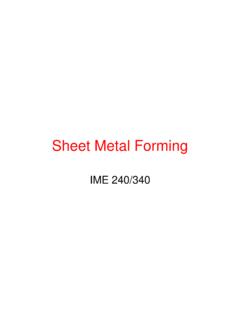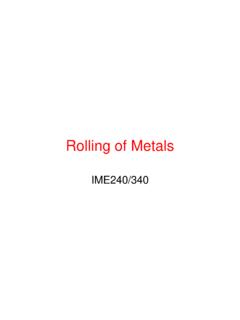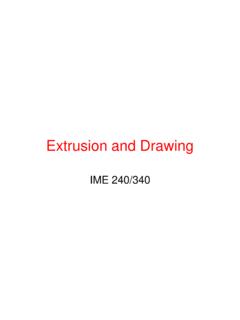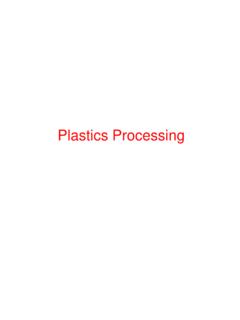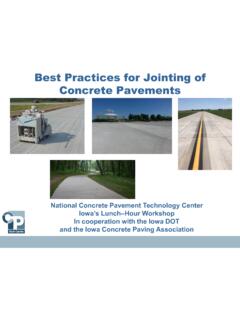Transcription of Machining Processes - University of Rhode Island
1 Machining ProcessesIME 240 Material Removal Processes Machining is the broad term used to describe removal of material from a workpiece Includes Cutting, Abrasive Processes (grinding), Advanced Machining Processes (electrical, chemical, thermal, hydrodynamic, lasers) Automation began when lathes were introduced in 1700s Now have computer numerical control (CNC) machines Machining operations are a systemconsisting of: Workpiece material, properties, design, temperature Cutting tool shape, material, coatings, condition Machine tool design, stiffness & damping, structure Fixture workpiece holding devices Cutting parameters speed, feed, depth of cutIndependent variablesRange of Material Removal ProcessesEnergy sourceTransfer mediumProcessEnergy sourceTransfer mediumProcessMechanicalRigidChemicalLiqu idGranularElectricalandChemicalLiquidLiq uid/Gaseous(granular)
2 ThermalGaseousElectricalLiquidEnergy beamGaseousorVacuumLaser beam machiningElectron beam machiningIon beam machiningtoolMachiningUltrasonicmachinin gabrasivevibrationsJet cuttinghigh pressure jetEDMtoolChemical machiningshieldfluidECMtoolelectrolyteFl ame cuttingPlasma cuttingtorchgasMaterial Removal Processes Material removal Processes are often required after casting or forming to: Improve dimensional accuracy Produce external and internal geometric features, sharp corners, or flatness not possible with forming or shaping Obtain final dimensions and surfaces with finishing operations Obtain special surface characteristics or textures Provide the most economical means of producing a particular part Limitations, because material removal Processes : Inevitably waste material Generally require more energy, capital, and labor than forming or shaping operations Can have adverse effects on the surface quality and properties, unless carried out properly, Generally take longer than shaping a product with other processesTypes of Machining Process Single Cutting Edge (Point) Processes Multi-Cutting Edge (Point) Processes Random Point Cutting Processes Abrasive Machining Within each category the basic motions (kinematics) differentiate one process from another Machine Tool Motions Primary motion that causes cutting to take place.
3 Feed motion that causes more of the part surface to be machined Rotations and/or translations of the workpiece or cutting toolSingle Point Machining OperationsPlaning Machine Primary motion is translation of the workpiece Feed motion is translation of the tool incrementally between cutsShaping Machine Primary motion is translation of the tool Feed motion is translation of the workpiece between cutsTurning OperationsPrimary motion is rotation of the workpieceFeed motion is translation of the cutting tool continuous driven by spindle rotationTurningTurning is the process for Machining round work-pieces on a latheWorkpieces Made by TurningLathe Componentsor, guideways or slidewaysCNC Lathe with Turrets(a)(b)Figure (a) A turret with six different tools for inside-diameter and outside-diameter cutting and threading operations.
4 (b) A turret with eight different cutting tools. Source: Monarch Machine Tool Devices3-jaw and 4-jaw ChucksMandrelsWorkholding Devices Collets and Face PlatesTurning FormulaefNlt dfNDDdfNDMRR foavg 2 Material removal rate (MRR) is the volume of material removed per unit time (mm3/min or in3/min)Cutting time (t) not including tool approach and speed, V = D0 NPower for Machining Power required at cutting tool = MRR * Specific cutting power Power at motor = power at cutting tool/ mechanical efficiency of drive systemTurning Parameters TABLE N = Rotational speed of the workpiece, rpm f = Feed, mm/rev or in/rev v = Feed rate, or linear speed of the tool along workpiece length, mm/min or in/min =fN V = Surface speed of workpiece, m/min or ft/min = Do N (for maximum speed) = Davg N (for average speed)
5 L = Length of cut, mm or in. Do = Original diameter of workpiece, mm or in. Df = Final diameter of workpiece, mm or in. Davg = Average diameter of workpiece, mm or in. = (Do +Df ) /2 d = Depth of cut, mm or in. = ( Do - Df ) /2 t = Cutting time, s or min =l/f N MRR = mm3/min or in3/min = Davg d fN Torque = Nm or lb ft = ( Fc )( Davg /2 ) Power = kW or hp = (Torque) ( ), where =2 radians/min Note: The units given are those that are commonly used; however, appropriate units must be used and checked in the formulas. Turning ConsiderationsTABLE causesTool breakageTool material lacks toughness; improper tool angles; machine tool lacks stiffness; worn bearings andmachine components; cutting parameters too tool wearCutting parameters too high; improper tool material; ineffective cutting fluid; improper tool surface finishBuilt-up edge on tool; feed too high; tool too sharp, chipped or worn; vibration and variabilityLack of stiffness; excessive temperature rise; tool chatterLack of stiffness; workpiece not supported rigidly; excessive tool overhang.
6 Design parts for ease of fixturing and clamping (avoid thin, slender parts) Specify wide tolerances and surface finishes if possible Avoid sharp corners, tapers, and major dimensional variations Use near-net-shape forming to reduce Machining cycle times Design features that only need standard cutting tools, inserts, and toolholders Select materials with good machinability Provide good support and stiffness in the turning operation Adjust parameters if chatter occursBoring Machining operation performed on the inside of a hollow workpiece of in a hole made previously by drilling or other Processes Deflection of the boring bar can cause dimensional inaccuracy High stiffness of the boring bar minimizes deflection, vibration, and chatter (such as tungsten carbide material or built-in damping devices) Design considerations.
7 Use through holes instead of blind holes if possible The greater the length-to-bore diameter ratio, the more difficult it is to hold dimensions because of deflections of the boring bar due to cutting forces Interrupted internal surfaces should be avoidedBoring MachinesFigure (a) Schematic illustration of a steel boring bar with a carbide insert. Note the passageway in the bar for cutting fluid application. (b) Schematic illustration of a boring bar with tungsten-alloy inertia disks sealed in the bar to counteract vibration and chatter during boring. This system is effective for boring bar length-to-diameter ratios of up to 6. (c) Schematic illustration of the components of a vertical boring mill. Source: Kennametal Horizontal boring mill. Source: Giddings and Lewis, Machining OperationsBroaching(a) Typical parts made by internal broaching.
8 (b) Parts made by surface broaching. Heavy lines indicate broached surfaces. Source: General Broach and Engineering Company. In broaching, multiple teeth machine internal or external surfaces such as holes, keyways, gear teeth, or flat surfaces Total depth of cut per stroke is the sum of the per tooth depths, up to 38 mm ( in) Expensive, but good productivity, surface finish, and dimensional accuracy Broach tool is pushed or pulled (preferred) through the workpiece The width of cut, or kerf, in sawing is narrow so less material is wasted At least 2 or 3 teeth should always be engaged in the workpiece to avoid snagging Hacksaws, Circular saws, Band saws, of various sawing operations. Source: DoALL Presses and Drill BitsFigure Various types of drills(a)Drilling Creating a hole in a workpiece by mounting a drill bit on the tailstock The most accurate holes are produced by centering, drilling, boring, and them reaming, as well as possibly honing or grinding to improve internal surface and deburring the tool exit surface of through holes Holemaking is a major cost of components such as engines Gang drilling produces multiple holes at once Drills can have high length-to-diameter ratios allowing them to drill deep holes Holes drilled on a lathe are not always concentric due to drift Long drill bits can deflect or break due to excessive thrust forces Chips must be removed from within the hole being drilled.
9 And coolant may need to be delivered into the holeDrilling ParametersfNDMRR 42 ergySpecificEnMRRP ower* SpeedRotationalPowerTorque Max. cutting speed= DNCutting Time = hole depth/ fN Designs should allow holes to be drilled on flat surfaces perpendicular to the drill motion to avoid deflection Avoid interrupted hole surfaces Use standard drill-point angles for hole bottoms if possible Through holes are preferred over blind holes If holes are large, workpiece should have a preexisting hole from forming or casting Design parts to minimize fixturing and repositioning It may be difficult to ream blind or intersecting holes due to the possibility of tool breakage so provide extra depth. Blind holes should be drilled deeper than subsequent reaming or tapping operationsDrilling ConsiderationsTroubleshooting Drilling ProcessesTABLE General Troubleshooting Guide for Drilling OperationsProblemProbable causesDrill breakageDull drill; drill seizing in hole because of chips clogging flutes; feed too high; liprelief angle too drill wearCutting speed too high; ineffective cutting fluid; rake angle too high; drill burnedand strength lost when holeDrill misaligned or bent; lips not equal; web not holeSame as above; machine spindle loose; chisel edge not central; side pressure hole surface finishDull drill; ineffective cutting fluid; welding of workpiece material on drill margin;improperly ground drill.
10 Improper The determination of drill life by monitoring the rise in force or torque as a function of the number of holes drilled. This test is also used for determining tap Trepanning produces a hole without reducing all of the removed material into chips Trepanning can produce disks up to 150 mm (6 inches) diameter from flat sheet or plates Trepanning can also be used to produce grooves for O-ringsCutting Screw Threads Threads may be right-handed or left-handed, straight or tapered Threads can be produced by forming (most), casting (with dimensional inaccuracy), or Machining (thread cutting) Standard Nomenclature is in Figures and Thread Considerations Designs should allow for termination of thread before they reach a shoulder or the bottom of a blind hole Eliminate shallow, blind tapped holes Use chamfers to minimize finlike threads with burrs Do not interrupt threads with slots, holes, or other discontinuities Use standard thread tooling and inserts when possible Thin-walled parts should have sufficient thickness and strength to resist clamping and cutting forces.
